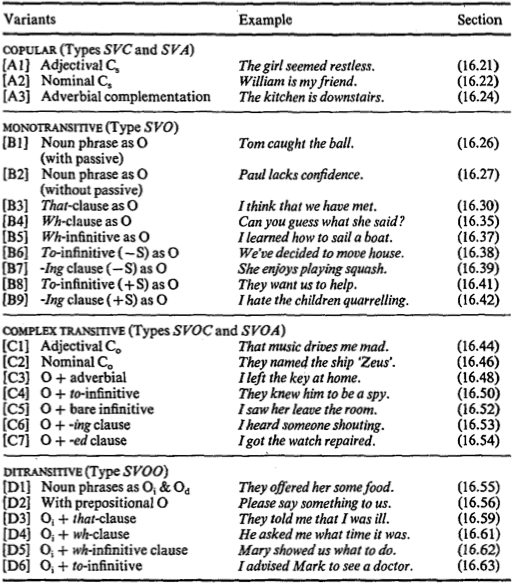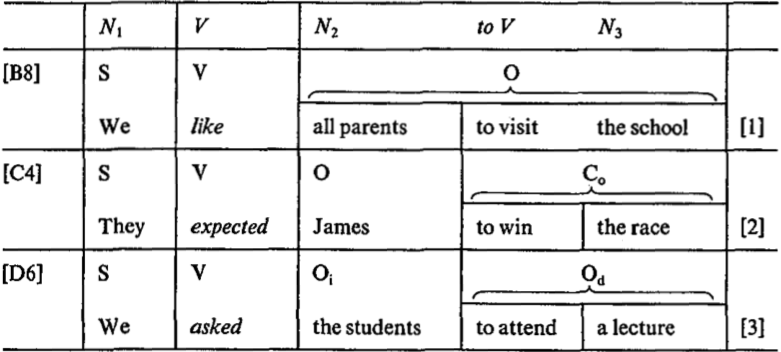SVOCのCは、厳密には「predicative complement(叙述補語)」と言います。素の「complement(補部)」は、叙述補語以外にも各種節や句を構成するのに必須の要素(例えば「前置詞の目的語(「with him」のhim)」なども一種のcomplementです)をも包含するため、その他complementと区別するためにそう呼ばれます(日本語の場合「補語」と「補部」で使い分けられるようですが)。
叙述補語(C)は、文の主語(S)や目的語(O)に付与された属性を表す、つまりそれがどんなものであるかを「叙述」するものです。
[A] predicative complement characteristically denotes a property that is ascribed to the referent of the subject or object.
(CaGEL, p. 53)
主格(叙述)補語(subjective predicative complement)の場合、主語になっている名詞の属性を表します(例:「ⓈMary is Ⓒpretty.」)。目的格(叙述)補語(objective predicative complement)の場合、目的語になっている名詞の属性を表す形になります(例:「Tom made ⓄMary Ⓒhappy.」)。
基本、叙述補語は形容詞句または名詞句(例:「ⓈMary is Ⓒa doctor.」)になります。形容詞句や名詞句ではないけれども、Vの構成要素として必須になる副詞句(例:「I have been in the garden all the time since lunch.」「You must put all the toys upstairs immediately.」)は、「副詞的補語(adverbial complement、A)」または「前置詞句補語(pp complement)」として別分類にされることもあります。
叙述補語がなぜ「叙述補語(predicative complement)」と呼ばれるかと言うと、意味的(semantically)に「述語(predicate)」と同等だからです。例えば「HeⓋis Ⓒa good speaker.」と「He Ⓥspeaks well.」は、動詞以降の意味がほぼ同じです。
[A]lthough a good speaker is syntactically an NP (名詞句) complement, it is semantically comparable to a predicate like spoke well. This is the basis for the term 'predicative complement': the complement typically represents what is predicated of the subject-referent in a way that is similar to that in which a whole predicate does.
(A Student's Introduction to English Grammar, pp. 73-74)
ということで、SVOCの文のOとCに当たる語は主述の関係にあり、それぞれ取り出して文を作ることもできます(例:「Tom made ⓄMary Ⓒhappy.」→「Mary was happy.」)⋯が、ややこしいことに、実はVの後に来る2語間において主述の関係が成立しうるものが全て「SVOC」の文型になるわけではないようです。
QuirkのCGELの場合
Quirkの『Comprehensive Grammar of the English Language』(1985年)では以下のように分類しています(2002年の『Cambridge Grammar of the English Language』の解説はその後に見ていきます):

- SVO(O=to不定詞)
They want us to help.(彼らは私たちに助けて欲しい。) - SVO(O=現在分詞)
I hate the children quarrelling.(私は子供たちが口論しているのが嫌いだ。) - SVOC(C=to不定詞)
They knew him to be a spy.(彼らは彼がスパイだと知っていた。)
My contract allows me to take one month's leave.(私の雇用契約は私が1ヶ月の休暇を取ることを許している。) - SVOC(C=原形不定詞)
I saw her leave the room.(私が彼女がその部屋を去るのを見た。) - SVOC(C=現在分詞)
I heard someone shouting.(私は誰かが叫んでいるのを聞いた。) - SVOC(C=過去分詞)
I got the watch repaired.(私はその腕時計を直してもらった) - SVOO(O=to不定詞)
I advised Mark to see a doctor.(私はマークに医者に行くことを勧めた)
(CGEL, p. 1171)
知覚動詞や使役動詞がSVOCの文型を取るという記述は日本の英語参考書でもよく見かけます。いずれも原形不定詞をCに取ることができますが、であれば目的語の後にto不定詞を取る他の動詞wantやadviseも同文型でいいような気がします...が、残念ながらそのような類推は成立しないようです。上述の通り、不定詞を含む文形はSVO、SVOC、SVOOの3パターンあります。あらためてto不定詞を用いるもののみ取り上げると:

- SVO(O=to不定詞):ⓈWe Ⓥlike Ⓞall parents to visit the school.
- SVOC(C=to不定詞):ⓈThey Ⓥexpected ⓄJames Ⓒto win the race.
- SVOO(O=to不定詞):ⓈWe Ⓥasked Ⓞthe students Ⓞto attend a lecture.
(CGEL, p. 1216)
という構造になります。
SVO(O=to不定詞)
SVOの場合、不定詞句の前にある名詞句は、不定詞句の動詞の意味上の主語になっています。例えば「I want you to study English.」であれば、studyをするのはyouです。そして「you to study English(あなたが英語を勉強すること)」全体がOになります。youの無い「I want to study English.」であれば「to study English」はOですから、まぁわからなくはありません。動名詞で書けば、所有格で意味上の主語を表して「your studying English」になりますし(無論、この文においては直接動名詞に書き換えはできませんが)。 youが単独ではOにならないのは、この文を受動態にすることができないことからも分かります:
- × You are not wanted to study English by me.
- Jack prefers his wife to drive the truck.
- Jack prefers for his wife to drive the truck.
(CGEL, p. 1193)
このことからも、SVOの文型であることがわかります。
SVOC(C=to不定詞)
SVOC(C=to不定詞)の形は、以下の動詞が取ることができます:
- announce, declare, proclaim, pronounce, report, repute, rumour, say, tip
- assume, believe, conceive,consider, expect, feel, find, imagine, know, presume, reckon, see, suppose, take, think, understand
- intend, mean
- appoint, elect, name, vote
- cause, drive, force, get, lead, prompt
- allow, authorize, compel, constrain, enable, entitle, equip, fit, oblige, permit, require
- assist, bother, bribe, condemn, dare, defy, encourage, help, induce, inspire, press, summon
- John believed Ⓞthe stranger to be a policeman.
- John believed that Ⓢthe stranger was a policeman.
- The stranger was believed to be a policeman.
- ○ The field marshal was said to be planning a new strategy.
- × Someone said the field marshal to be planning a new strategy.
SVOO(O=to不定詞)
SVOO(O=to不定詞)の形は、以下の動詞が取ることができます:
- advise, command, entreat, instruct, remind, teach, ask, counsel, exhort, invite, request, tell, beg, detail, forbid, order, recommend, urge, beseech, direct, implore, persuade, challenge, enjoin, incite, pray
- I told/advised/persuaded Mark to see a doctor.(マークに、医者にかかるるよう、言った/勧めた/説得した。)
- Mark was told/advised/persuaded to see a doctor.
(続く)
